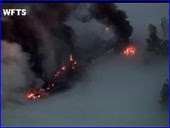
According to reports, smoke from an escaped prescribed fire combined with fog contributed to a 50-car pileup and three deaths on Interstate 4 in Florida between Orlando and Tampa. ABC Action News reported yesterday, January 8:
“POLK COUNTY– Crews are working to put out an oversized brush fire in Polk County.
Officials with the Division of Forestry say they issued a 50 acre prescribed burn today in the area of Old Grade Road and I-4.
They believe the wind may have led the fire to grow by an extra 200 acres.
They say no homes are being threatened at this time.
There are concerns that if the fire burns overnight, drivers may face smoky conditions by Wednesday morning.”
Then today ABC Action News further reports in a story about the incident:
“A mixture of fog and smoke from a controlled burn near Old Grade Road created extremely hazardous conditions early this morning.
The burn was supposed to cover only 50 acres, but got out of hand late yesterday and grew to more than 300 acres.“
More information from MyFox Tampa Bay:
“POLK CITY – Smoke and fog are causing a surreal scene in Polk County that’s forced the closure of a stretch of Interstate 4, and contributed to a massive pile-up.
All lanes of I-4 are closed between the Polk Parkway and U.S. 27. That’s roughly from Polk City to the Osceola County line.
The lingering smoke combined with the morning fog has brought visibility down to near zero, and deputies say at least 50 vehicles are involved in the massive wreck, and 20 of those are semi-trucks. Several vehicles caught fire, though most of the blazes seemed to be out by 8:30 a.m., judging by the diminishing amount of black smoke rising from the scene.
At least three people are dead, and several more motorists are trapped and waiting for emergency crews.
Those who are unhurt are being asked to stay in their cars for their own safely and the safety of rescue workers.
Yesterday’s brush fire began as a controlled burn, but it jumped a firebreak and eventually grew to 250 acres before being contained.”
According to TheLedger.com a Division of Forestry dozer was burned in the fire yesterday.




